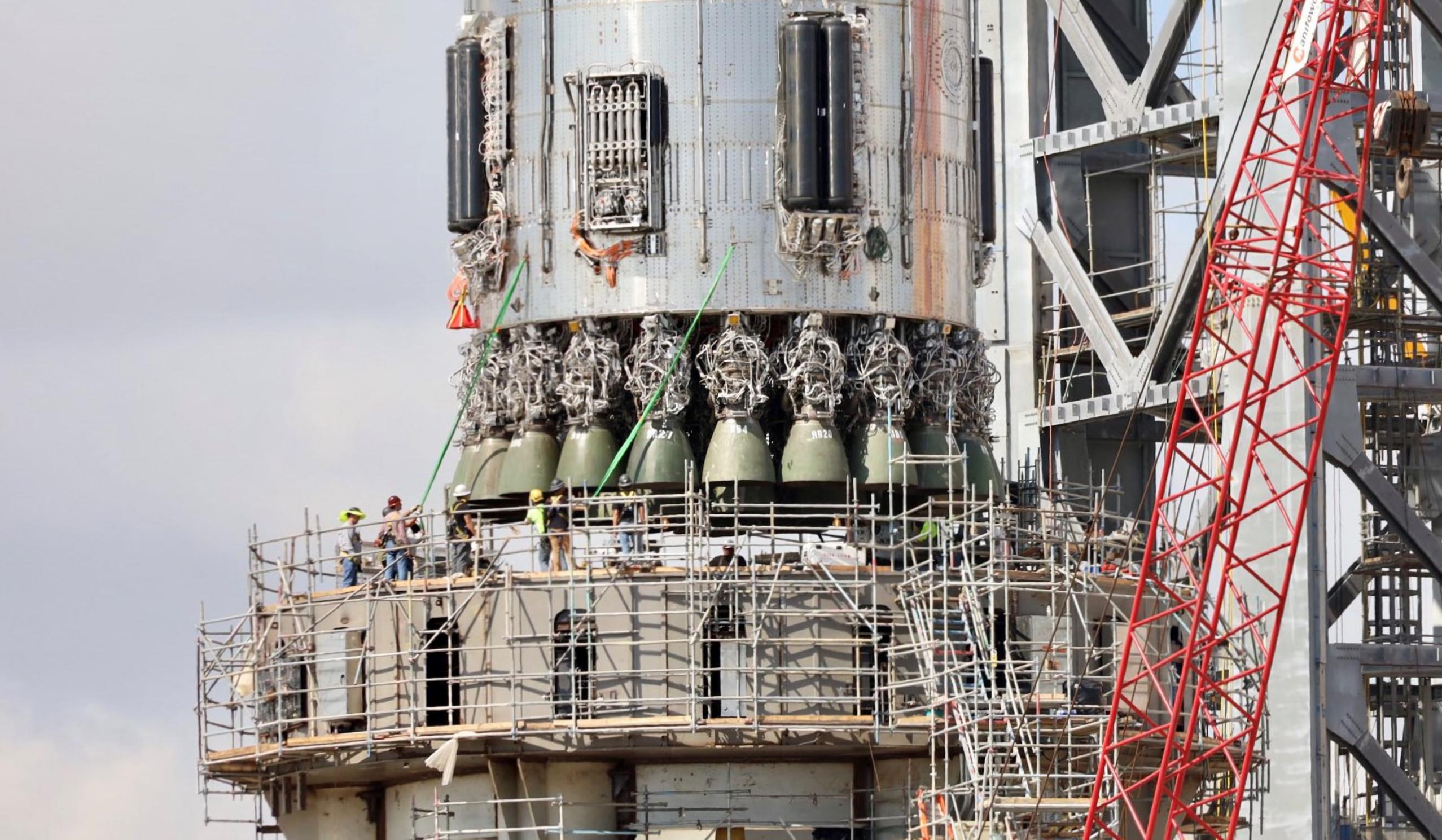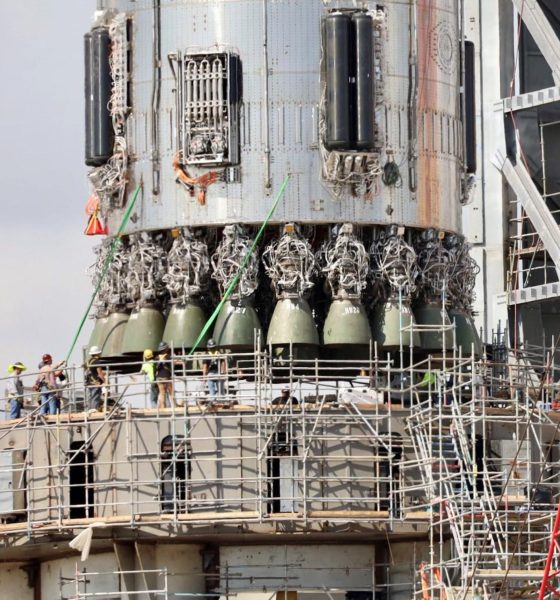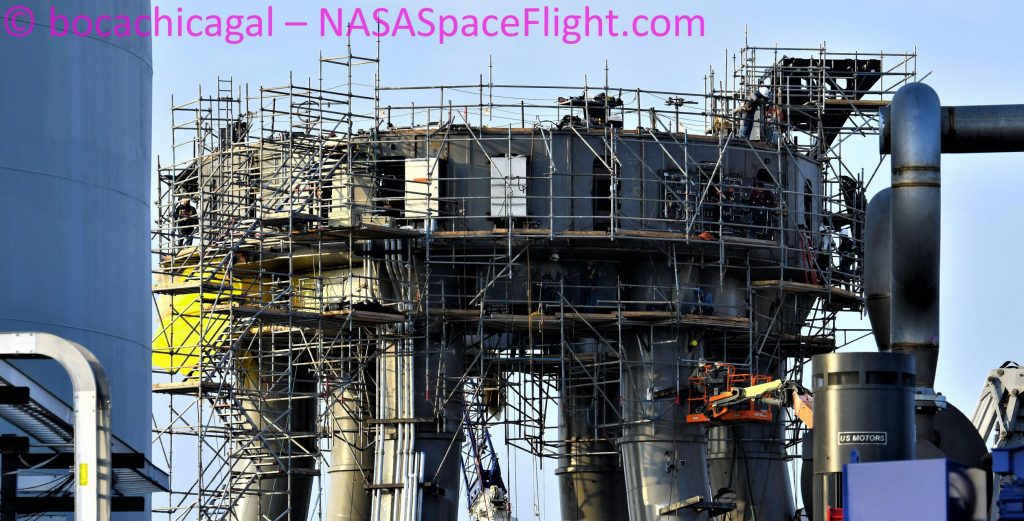

News
Elon Musk says SpaceX could fire up first orbital-class Super Heavy booster next week
Update: In response to this article, SpaceX CEO Elon Musk says that the plan is to not only ‘cryoproof’ the first flightworthy Super Heavy – but to static fire the booster and shake down Starship’s brand new orbital launch complex as early as “next week.”
A lot of work would need to be finished – and all of it smoothly – for an orbital launch pad cryoproof and static fire to be possible just a week or less from now but Musk’s response nevertheless provides invaluable context for SpaceX’s near-term plans and confirms that Super Heavy Booster 4 is ready for integrated testing as-is. Further, Musk’s tweet implies – as speculated – that Starbase’s orbital launch complex tank farm is much closer to test-readiness than it might otherwise appear.
For the second time in five weeks, SpaceX has installed a Super Heavy booster – fitted with 29 Raptor engines – on Starship’s nascent ‘orbital launch mount.’
Both Super Heavy Booster 4 (B4) and the launch mount have undergone substantial changes since they last parted ways four weeks ago. SpaceX teams have been laser-focused on installing the vast array of plumbing, wiring, and components required to turn the hulking steel structures into functional launch facilities and the largest flightworthy rocket and both certainly look the part.
Superheavy Booster 4 pic.twitter.com/jQ7RAN1nCK— SPadre (@SpacePadreIsle) September 8, 2021
Unlike Starship, which has an expansive skirt section perfect for stowing away sensitive plumbing and avionics, Super Heavy has an unusually short interstage and no real skirt, meaning that all the extra hardware SpaceX has installed over the last month or so is impossible to hide. Indeed, when Booster 4 rolled out of Starbase’s high bay for the second time on September 8th, the rocket was blanketed by dozens of new valves, thousands of feet of wiring and plumbing, pressure vessels, multiple hydraulic racks, a ‘quick disconnect’ (QD) umbilical panel for interfacing with the launch pad, places for “flight termination system” (FTS) explosive charges to be installed, and much, much more.

Additionally, Super Heavy B4’s second batch of 29 Raptors – installed in late August – also appear to all have outward-facing umbilical panels that will all the booster to receive some level of assistance from ground systems while igniting those engines. It’s unclear what exactly they’ll do but it’s likely that those engine umbilical will connect to high-pressure gas systems on the ground, presumably minimizing the already absurd amount of COPVs and secondary plumbing present on Super Heavy.
However, Super Heavy will still need to be able to reignite anywhere from 1 to 13 of its 29-32 Raptor engines in flight for boostback and landing burns, potentially explaining the eight large pressure vessels and 100+ small, high-pressure gas lines installed on B4’s aft end. Super Heavy also needs to be able to chill, feed, and purge all 29-32 of its Raptor engines, guaranteeing that Starship’s booster plumbing situation was going to be immensely complex no matter the approach SpaceX took.
In addition to Super Heavy B4’s newfound complexity, SpaceX also spent the last four or so weeks outfitting Starbase’s orbital launch mount’ with all the plumbing, power, avionics, and mechanical systems it will need to function as “Stage Zero” of orbital-class, two-stage Starship rockets. SpaceX has installed most of the secondary quick disconnect structures that will connect to and feed each of Super Heavy’s 20 outer Raptor engines. The main Super Heavy quick disconnect device was also installed and a team has been gradually outfitting and connecting the structure to the plumbing, avionics, and power it will provide boosters.

A significant amount of work still remains to connect the orbital launch mount to SpaceX’s incomplete and custom-built orbital tank farm, which will store, supercool, and feed the pad, Super Heavy, and Starship with several thousand metric tons of liquid and gaseous oxygen and methane. It’s difficult to say how close Starbase’s tank farm is to being able to support Starship or Super Heavy testing, which makes it equally unclear what SpaceX’s near-term plans are for Booster 4. It’s possible that the rocket has been reinstalled on the orbital launch mount as a second fit check, perhaps focused on those 20 outer Raptor quick-disconnect mechanisms.
It’s also possible that the tank farm and launch mount plumbing are much closer to completion than expected, meaning that Super Heavy B4 could remain at the orbital pad until it’s completed several crucial cryogenic proof and static fire tests. Of course, short of confirmation from Musk himself, we’ll just have to wait and see.

News
Tesla hints at Starlink integration with recent patent
“By employing polymer blends, some examples enable RF transmission from all the modules to satellites and other communication devices both inside and outside the vehicle.”

Tesla hinted at a potential Starlink internet terminal integration within its vehicles in a recent patent, which describes a vehicle roof assembly with integrated radio frequency (RF) transparency.
The patent, which is Pub. No U.S. 2025/0368267 describes a new vehicle roof that is made of RF-transparent polymer materials, allowing and “facilitating clear communication with external devices and satellites.”
Tesla believes that a new vehicle roof design, comprised of different materials than the standard metallic or glass elements used in cars today, would allow the company to integrate modern vehicular technologies, “particularly those requiring radio frequency transmission and reception.
Tesla has recently filed a US patent application on integrating RF transparent materials into the roof structure.
“facilitating clear communication with external devices and satellites”
Tesla fleet is getting @Starlink connectivity integration soon. LFG @Tesla @elonmusk… pic.twitter.com/bLa8YtPLd1
— Chansoo Byeon (@Chansoo) December 9, 2025
Instead of glass or metallic materials, Tesla says vehicles may benefit from high-strength polymer blends, such as Polycarbonate, Acrylonitrile Butadiene Styrene, or Acrylonitrile Styrene Acrylate.
These materials still provide ideal strength metrics for crashworthiness, stiffness for noise, vibration, and harshness control, and are compliant with head impact regulations.
They would also enable better performance with modern technologies, like internet terminals, which need an uninterrupted signal to satellites for maximum reception. Tesla writes in the patent:
“By employing polymer blends, some examples enable RF transmission from all the modules to satellites and other communication devices both inside and outside the vehicle.”

One of the challenges Tesla seems to be aware of with this type of roof design is the fact that it will still have to enable safety and keep that at the forefront of the design. As you can see in the illustration above, Tesla plans to use four layers to increase safety and rigidity, while also combating noise and vibration.
It notes in the patent that disclosed examples still meet the safety requirements outlined in the Federal Motor Vehicle Safety Standards (FMVSS).
Starlink integrated directly into Tesla vehicles would be a considerable advantage for owners. It would come with a handful of distinct advantages.
Initially, the inclusion of Starlink would completely eliminate cellular dead zones, something that is an issue, especially in rural areas. Starlink would provide connectivity in these remote regions and would ensure uninterrupted service during road trips and off-grid adventures.
It could also be a critical addition for Robotaxi, as it is crucial to have solid and reliable connectivity for remote monitoring and fleet management.
Starlink’s growing constellation, thanks to SpaceX’s routine and frequent launch schedule, will provide secure, stable, and reliable internet connectivity for Tesla vehicles.
Although many owners have already mounted Starlink Mini dishes under their glass roofs for a similar experience, it may be integrated directly into Teslas in the coming years, either as an upgrade or a standard feature.
News
Tesla supplements Holiday Update by sneaking in new Full Self-Driving version
It seems Tesla was waiting for the Hardware 4 rollout, as it wanted to also deploy a new Full Self-Driving version to those owners, as it appeared in the release notes for the Holiday Update last night.

Tesla has surprised some owners by sneaking in a new Full Self-Driving version with the wide release of the Holiday Update, which started rolling out to Hardware 4 owners on Friday night.
Tesla has issued a controlled and very slow release pattern with the Holiday Update, which rolls out with Software Version 2025.44.25.5.
For the past two weeks, as it has rolled out to Hardware 3 and older Tesla owners, the company has kept its deployment of the new Software Version relatively controlled.
It seems Tesla was waiting for the Hardware 4 rollout, as it wanted to also deploy a new Full Self-Driving version to those owners, as it appeared in the release notes for the Holiday Update last night.
Tesla Full Self-Driving v14.2.1.25 made its first appearance last night to Hardware 4 owners who are members of the Early Access Program (EAP). It appears to be a slight refinement from FSD v14.2.1, which has been out for a couple of weeks.
Tesla v2025.44.25.5 Holiday update incoming
Also Full Self-Driving v14.2.1.25!!! pic.twitter.com/74D7S0UGXz
— TESLARATI (@Teslarati) December 13, 2025
Many owners welcome the new FSD version, us included, because we’ve been less than impressed with v14.2.1. We have experienced some minor regressions with v14.2.1, especially with Speed Limit recognition, Speed Profile tinkering, and parking performance.
As it stands, Full Self-Driving is still particularly impressive, but Tesla is evidently having an issue with some of the adjustments, as it is still refining some of the performance aspects of the suite. This is expected and normal with some updates, as not all of them are an improvement in all areas; we routinely see some things backtrack every once in a while.
This new FSD version is likely to take care of those things, but it also includes all of the awesome Holiday Update features, which include:
- Grok with Navigation Commands (Beta) – Grok will now add and edit destinations.
- Tesla Photobooth – Take pictures inside your car using the cabin-facing camera
- Dog Mode Live Activity – Check on your four-legged friend on your phone through periodic snapshots taken of the cabin
- Dashcam Viewer Update – Includes new metrics, like steering wheel angle, speed, and more
- Santa Mode – New graphics, trees, and a lock chime
- Light Show Update – Addition of Jingle Rush light show
- Custom Wraps and License Plates – Colorizer now allows you to customize your vehicle even further, with custom patterns, license plates, and tint
- Navigation Improvements – Easier layout and setup
- Supercharger Site Map – Starting at 18 pilot locations, a 3D view of the Supercharger you’re visiting will be available
- Automatic Carpool Lane Routing – Navigation will utilize carpool lanes if enabled
- Phone Left Behind Chime – Your car will now tell you if you left a phone inside
- Charge Limit Per Location – Set a charge limit for each location
- ISS Docking Simulator – New game
- Additional Improvements – Turn off wireless charging pad, Spotify improvements, Rainbow Rave Cave, Lock Sound TRON addition
Tesla also added two other things that were undocumented, like Charging Passport and information on USB drive storage to help with Dashcam.
Cybertruck
Tesla updates Cybertruck owners about key Powershare feature

Tesla is updating Cybertruck owners on its timeline of a massive feature that has yet to ship: Powershare with Powerwall.
Powershare is a bidirectional charging feature exclusive to Cybertruck, which allows the vehicle’s battery to act as a portable power source for homes, appliances, tools, other EVs, and more. It was announced in late 2023 as part of Tesla’s push into vehicle-to-everything energy sharing, and acting as a giant portable charger is the main advantage, as it can provide backup power during outages.
Cybertruck’s Powershare system supports both vehicle-to-load (V2L) and vehicle-to-home (V2H), making it flexible and well-rounded for a variety of applications.
However, even though the feature was promised with Cybertruck, it has yet to be shipped to vehicles. Tesla communicated with owners through email recently regarding Powershare with Powerwall, which essentially has the pickup act as an extended battery.
Powerwall discharge would be prioritized before tapping into the truck’s larger pack.
However, Tesla is still working on getting the feature out to owners, an email said:
“We’re writing to let you know that the Powershare with Powerwall feature is still in development and is now scheduled for release in mid-2026.
This new release date gives us additional time to design and test this feature, ensuring its ability to communicate and optimize energy sharing between your vehicle and many configurations and generations of Powerwall. We are also using this time to develop additional Powershare features that will help us continue to accelerate the world’s transition to sustainable energy.”
Owners have expressed some real disappointment in Tesla’s continuous delays in releasing the feature, as it was expected to be released by late 2024, but now has been pushed back several times to mid-2026, according to the email.
Foundation Series Cybertruck buyers paid extra, expecting the feature to be rolled out with their vehicle upon pickup.
Cybertruck’s Lead Engineer, Wes Morrill, even commented on the holdup:
As a Cybertruck owner who also has Powerwall, I empathize with the disappointed comments.
To their credit, the team has delivered powershare functionality to Cybertruck customers who otherwise have no backup with development of the powershare gateway. As well as those with solar…
— Wes (@wmorrill3) December 12, 2025
He said that “it turned out to be much harder than anticipated to make powershare work seamlessly with existing Powerwalls through existing wall connectors. Two grid-forming devices need to negotiate who will form and who will follow, depending on the state of charge of each, and they need to do this without a network and through multiple generations of hardware, and test and validate this process through rigorous certifications to ensure grid safety.”
It’s nice to see the transparency, but it is justified for some Cybertruck owners to feel like they’ve been bait-and-switched.








